Right-Sizing Your Facility for Expansion Design
By Tertia Dex, Principal Consultant, Connected Workplaces
Your manufacturing company is thriving, but you've hit a ceiling, customer orders are piling up faster than you can fulfil them.
Or perhaps you've spotted a significant market gap and secured substantial funding to build a state-of-the-art manufacturing facility.
Either way, you're facing a critical question: How do you ensure your new building or facility expansion delivers genuine value and a solid return on investment?
The answer lies in strategic right-sizing, building what you need today while creating flexibility for tomorrow's growth.
Start with a Strong Business Foundation
Before breaking ground or signing contracts, your front-end planning must be anchored in a robust business model. Understanding your target market, business drivers, competitive differentiators, client needs, and risk profile is essential to defining both short-term operational requirements and long-term strategic goals.
Data-driven business and risk profiling creates strategic alignment among stakeholders and identifies potential pitfalls before they become costly problems. This approach helps you define the operational flexibility your company needs, enabling smart facility design that can adapt as your business evolves. A thorough front-end planning process is the foundation of a sustainable business capable of weathering long-term market fluctuations.
Key considerations for business modelling:
Assemble a leadership and technical team with the expertise to develop resilient long-term plans that can handle market volatility
Articulate both technical and commercial strategies for the near and distant future
Establish a realistic cost basis and understand schedule constraints
Begin with the end in mind, creating an operational model that meets future business needs without excessive capital expenditure
Define Your Facility's Operational Parameters
Once your business strategy is clear, translate it into concrete facility requirements. Start by understanding the process and equipment specifications, growth projections, and systems and utilities necessary to operate in compliance with industry regulations specific to your manufacturing sector.
Determine whether your facility will support clinical manufacturing, commercial production, or both, and identify which product types and technologies you'll be producing. If you're implementing multiple technologies, ensure they fall under the same regulatory framework to simplify facility design and establish clear segregation policies that prevent cross-contamination.
Be cautious about planning different technologies overseen by separate regulatory bodies for the same production line. This can create significant challenges in licensing and may undermine customer confidence in your changeover procedures, a business risk that could prove too costly to accept.
Consider the scale of your processes based on supply modelling and market demand data. This analysis will inform your equipment selection and facility sizing decisions, ensuring you build neither too large nor too small.
Build Smart: Conservative Start, Flexible Future
The most successful facility designs start conservative and scale with proven demand. Rather than building for your maximum theoretical capacity from day one, tie your predicted operational schedule increases to actual market demand growth data. Remember, you won't capture 100% of any market… plan accordingly.
Strategies for flexible facility design:
Identify potential customers early and offer incentives to early adopters willing to manufacture the first products on new lines
Implement a modular approach to process equipment, allowing production customization for different products to maximize your client base
For clinical materials or low-volume products, consider single-use equipment to reduce operational demands by eliminating cleaning, sanitization, and additional validation requirements
Design spaces with future capacity increases in mind, plan for expanded production, enhanced analytical capabilities, and increased inventory storage within your existing footprint
If larger equipment may be needed later, ensure your design accommodates installation into confined spaces through removable walls or by specifying equipment that can be disassembled for transport through existing elevators and doorways
Plan for Growth Within Your Existing Space
Once your facility is operational, ramp up production as market demand materializes. Base your capacity assessments on predicted demand but continuously adjust according to actual requests. Increase capacity by optimizing operational run rates first, then by adding shift work, and finally by considering nights and weekends as you approach maximum capacity.
At this stage, additional equipment may become necessary. That's why building expansion space into your original design, within production lines, quality control laboratories, and warehousing areas, is crucial.
Workforce and operational considerations:
Develop hiring plans that accommodate staggered workforce growth, comprehensive training programs, and the operational overheads associated with expansion and shift work
Strike the right balance to meet quality assurance and regulatory requirements without over-staffing
Before expanding your facility, apply operational excellence principles to assess manufacturing efficiency and analytical output, identify opportunities for process and procedural improvements that increase capacity without capital investment
This disciplined approach protects your business from over-capitalisation and unsustainable overhead costs while ensuring you're positioned to meet genuine market demand.
The Bottom Line
Right-sizing your manufacturing facility isn't about guessing the future, it's about creating a flexible foundation that grows with your business. By combining robust business planning, thoughtful facility design, and disciplined capacity management, you can build a facility that delivers strong ROI today while positioning your company for sustainable growth tomorrow.

